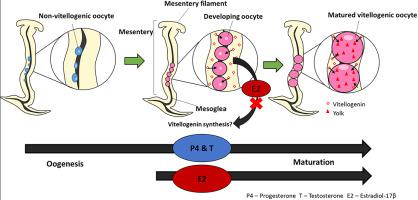Comparative Biochemistry and Physiology A: Molecular & Integrative Physiology ( IF 2.1 ) Pub Date : 2021-01-22 , DOI: 10.1016/j.cbpa.2021.110910 Ee Suan Tan 1 , Hirono Hamazato 1 , Takahiro Ishii 2 , Kenshiro Taira 3 , Yuki Takeuchi 4 , Hiroki Takekata 5 , Naoko Isomura 6 , Akihiro Takemura 7

|
Most broadcast spawner corals have a vitellogenic phase that lasts at least 6 months. It is established that estrogen regulates vitellogenin synthesis in vertebrates. Although some research have been conducted on the physiological role of sex steroids in corals, little is known about their involvement in oocyte development. This study aimed to detect steroid hormones – progesterone, testosterone, and estradiol-17β (E2) – in Acropora tenuis and study the relationships between vitellogenesis/vitellogenin synthesis and these steroids. This study also investigated the effect of E2 on vitellogenin synthesis in corals and identified steroidogenic enzymes in A. tenuis genome. Branches from tagged coral colonies were collected monthly from March to November. Histological observations showed that oocytes were vitellogenic from March to May (Stage IV and V), but not in June, and that gonads were occupied by immature oocytes in September (Stage I). Real-time qPCR revealed that vitellogenin (vg1 and vg2) transcript levels in coral branches were high in April and May, implying that corals actively underwent vitellogenesis during these months, and spawned before June. Liquid chromatography-mass spectrometry revealed that E2 could be detected in coral branches in March, April, and May, but not in June, whereas testosterone and progesterone did not fluctuate much in the same months. Immersing branches in E2–containing seawater failed to increase vitellogenin transcript levels. The results indicate that E2 is involved in oogenesis but does not positively regulate vitellogenin synthesis. Steroidogenic enzymes (except CYP19A) were identified in A. tenuis, suggesting that corals may endogenously synthesize progestogens and androgens from cholesterol.
中文翻译:

雌激素会调节珊瑚中的卵黄蛋白原合成吗?
大多数广播产卵珊瑚具有持续至少 6 个月的生卵期。已确定雌激素调节脊椎动物卵黄蛋白原的合成。尽管已经对性类固醇在珊瑚中的生理作用进行了一些研究,但对其参与卵母细胞发育的情况知之甚少。本研究旨在检测鹿角珊瑚中的类固醇激素——黄体酮、睾酮和雌二醇-17β (E2),并研究卵黄生成/卵黄蛋白原合成与这些类固醇之间的关系。本研究还研究了 E2 对珊瑚卵黄蛋白原合成的影响,并鉴定了A. tenuis 中的类固醇生成酶基因组。从 3 月到 11 月,每月收集标记珊瑚群落的树枝。组织学观察表明,卵母细胞在 3 月至 5 月(IV 期和 V 期)产生卵黄,但在 6 月没有,9 月未成熟卵母细胞占据性腺(I 期)。实时 qPCR 显示卵黄蛋白原 ( vg1和vg2) 珊瑚分支的转录水平在 4 月和 5 月很高,这意味着珊瑚在这几个月里积极地经历了卵黄生成,并在 6 月之前产卵。液相色谱-质谱分析显示,E2 在 3 月、4 月和 5 月的珊瑚枝中可检测到,但在 6 月未检测到,而睾酮和孕酮在同一月份波动不大。将分支浸入含有 E2 的海水中未能增加卵黄蛋白原转录水平。结果表明 E2 参与卵子发生但不积极调节卵黄蛋白原的合成。在A. tenuis中鉴定出类固醇生成酶(CYP19A 除外),这表明珊瑚可以从胆固醇内源性合成孕激素和雄激素。









































 京公网安备 11010802027423号
京公网安备 11010802027423号